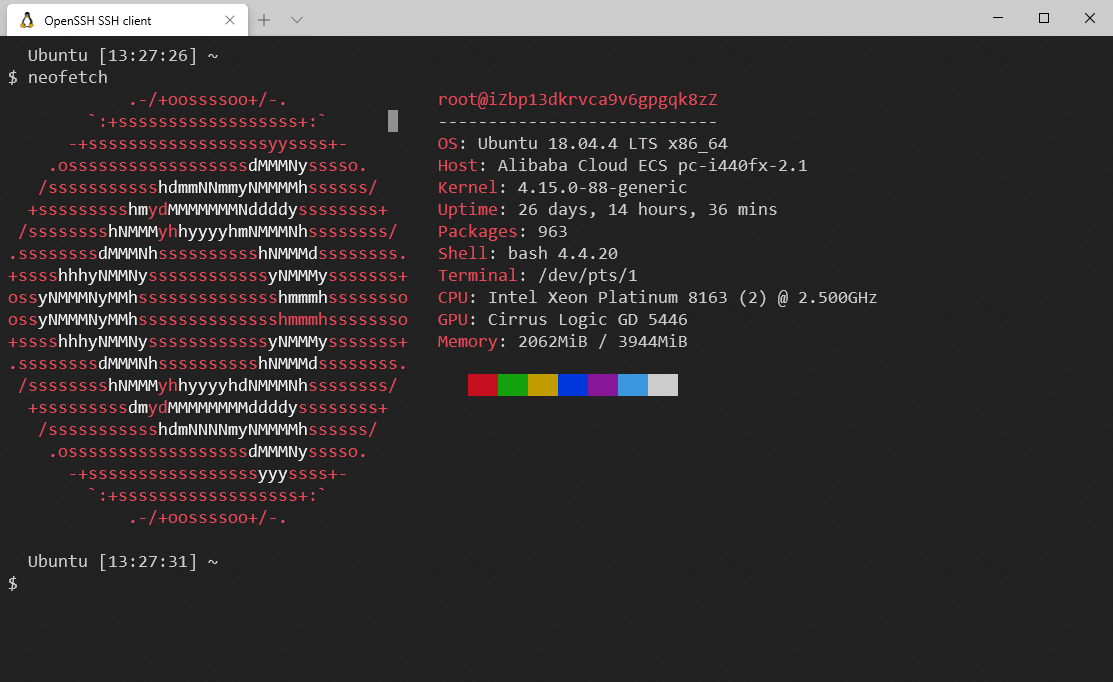
文件
sed

-
s命令sed 's/book/books/' log.txt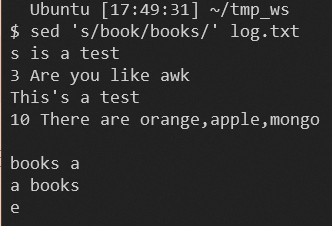
-
s命令, 只打印替换过的行/p打印处理过的行-n仅显示处理过后的结果
sed -n 's/book/books/p' log.txt
-
/d命令sed '/book/d' log.txt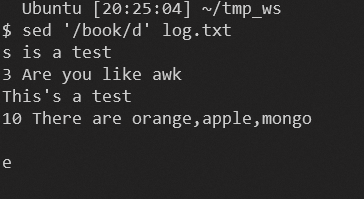
-
&指代已匹配的字符sed 's/book/&s/' log.txt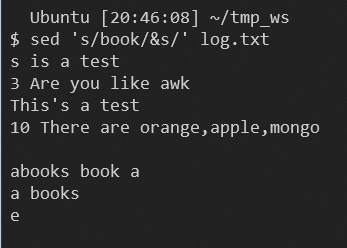
-
-e多次执行 -
a\在匹配到的下一行追加 -
i\在匹配到的下一行追加 -
;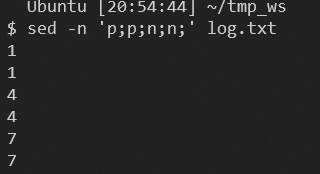
-
查看空格, tab
sed -n l log.txt this is tab\tfinish.$ this is several space finish.$
wc

行数, 单词数, 字节数, 文件名
l行数w单词数c字符数
cut

-
按字节
-b, 按字符-c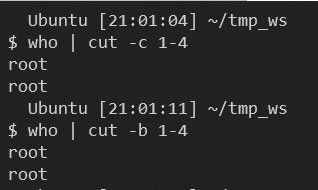
-
-fcat /etc/passwd | tail -n 5 | cut -d : -f 1,3
sort
-o指定文件名保存-f忽略大小写-u删除重复行-r反向-R乱序-t分隔符,-k-n按数值
uniq
-c计数-d只输出重复-u只输出不重复-i忽略大小写-f跳过前n个域-s跳过前n个字符
awk

-
$0当前行,$n第n个字段 -
-F指定分隔符 -
-f指定文件 -
变量
NF代表字段数 -
变量
NR代表当前行数 -
{}字符串使用双引号cat /etc/passwd | head -n 5 | awk -F ':' '{print $1", "$2}'
-
toupper(),tolower() -
条件
cat /etc/passwd | awk -F ':' 'NR % 2 == 1 {print $1}'
tr

-
字符集1 替换为 字符集2
cat words.txt | tr -s ' ' '\n'
EXAMPLES
重复次数最多的5条命令
注意使用
-n按数值排序
history | awk {'print $2'} | sort | uniq -c | sort -nr -k1,1 | head -n 5192. Word Frequency
Difficulty: Medium
Write a bash script to calculate the frequency of each word in a text file words.txt.
For simplicity sake, you may assume:
words.txtcontains only lowercase characters and space' 'characters.- Each word must consist of lowercase characters only.
- Words are separated by one or more whitespace characters.
Example:
Assume that words.txt has the following content:
the day is sunny the the
the sunny is is
Your script should output the following, sorted by descending frequency:
the 4
is 3
sunny 2
day 1
Note:
- Don’t worry about handling ties, it is guaranteed that each word’s frequency count is unique.
- Could you write it in one-line using ?
Solution
Language: Bash
# Read from the file words.txt and output the word frequency list to stdout.
cat words.txt | tr -s ' ' '\n' | sort | uniq -c | sort -nr -k 1,1 | awk '{print $2" "$1}'193. Valid Phone Numbers
Difficulty: Easy
Given a text file file.txt that contains list of phone numbers (one per line), write a one liner bash script to print all valid phone numbers.
You may assume that a valid phone number must appear in one of the following two formats: (xxx) xxx-xxxx or xxx-xxx-xxxx. (x means a digit)
You may also assume each line in the text file must not contain leading or trailing white spaces.
Example:
Assume that file.txt has the following content:
987-123-4567
123 456 7890
(123) 456-7890
Your script should output the following valid phone numbers:
987-123-4567
(123) 456-7890
Solution
Language: Bash
# Read from the file file.txt and output all valid phone numbers to stdout.
cat file.txt | awk '/^[0-9][0-9][0-9]\-[0-9][0-9][0-9]\-[0-9][0-9][0-9][0-9]$/ || /^\([0-9][0-9][0-9]\) [0-9][0-9][0-9]\-[0-9][0-9][0-9][0-9]$/ {print $0}'磁盘管理
atime, mtime, ctime
- Access:
cat,more,less - Modify
- Change
- 只Change, 不Modify的情况:
mv,chrown
/etc/passwd
用户名:口令:用户标识号:组标识号:注释性描述:主目录:登录Shell

进程管理
ps
a: show processes for all usersu: display the process’s ownerx: also show processes not attached to a terminal
kill
-1,HUP: 中断终端-2,ctrl + c-9,KILL:强制终止-18,CONT: 继续, 与19相反-19,STOP,ctrl + z
网络
tcpdump

netstat

-a: 包含LISTEN的-t: tcp-u: udp-l: 只包含LISTEN-s: 各种协议的统计信息-p: 显示连线的进程使用-n: 不要解析dns-c: 隔一秒输出一次
lsof

Linux 一切皆文件
-
-u: 某个用户打开的文件信息 -
-c: 某个程序打开的文件信息 -
-i: 网络连接-
所有的tcp
lsof -i tcp -
:3306: 按端口查找lsof -i :3306
-
-
-p: 通过进程号查找
nc

-n: 不适用dns, 直接使用ip-u: 扫描udp, 默认是tcp
tcpdump

-
监听指定的host
tcpdump host 210.27.48.1 -
监听本机udp且端口为123
tcpdump udp port 123
telnet
-
查看端口是否开放
telnet chunibyo.xyz 22
whois
-
查看域名信息
whois chunibyo.xyz
traceroute
traceroute www.baidu.com-m限制跳数
mtr
ping+traceroute
iptables
- 4个表
- nat(状态转换表)
- filter(数据过滤表)
- raw(状态跟踪表)
- mangle(包标记表)
- 内置链
- input(入站)
- output(出站)
- forward(转发)
- prerouting(路由前)
- postrouting(路由后)
-t: 指定表名-t filter-A: 给链追加 规则-A INPUT-p: 指定协议名-p tcp-j: option-j DROP--dport: 指定端口--dport 8081
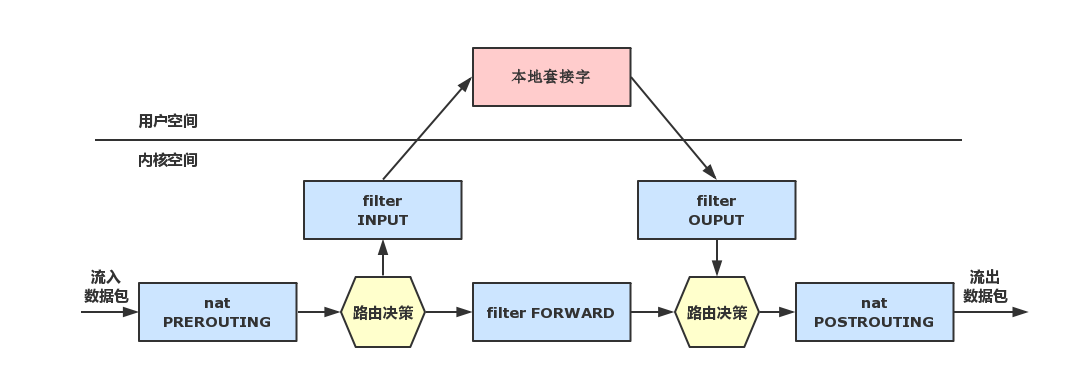
-
重置已有规则
iptables -X -
拒绝所有input流量
iptables -P INPUT DROP -
DNAT(Destination Network Address Translation): 目的地址转换
-
SNAT(Source Network Address Translation): 源地址转换
怕其他
gdb
g++ -g: Produce debugging information in the operating system’s native format (stabs, COFF, XCOFF, or DWARF). GDB can work with this debugging information.run:r断点处停止next: 单步运行, 不进入函数step: 单步运行, 进入函数break/delete n: 第n行设置/删除断点enable/disable n: 第n行开启/暂停断点listprintwatch: 监视的表达式值变化, 停止程序
二、主机规划与磁盘分区
2.2 磁盘分区
磁盘(按照政策顺序) /dev/sd[a-p]
分区: primary, extend
MBR(master boot recoder): 主要开机记录区, 安装开机管理程序的地方
2.2.3 BIOS 和 UEFI
固件: 写到硬件上的一个软件程序
BIOS: 计算机主动执行的第一个程序
开机到操作系统前的流程:
- BIOS:开机主动执行的固件,会认识第一个可开机的设备;
- MBR:第一个可开机设备的第一个扇区内的主要开机记录区块,内含开机管理程序;
- 开机管理程序(boot loader):一支可读取核心文件来执行的软件;
- 核心文件:开始操作系统的功能…
2.2.4 挂载
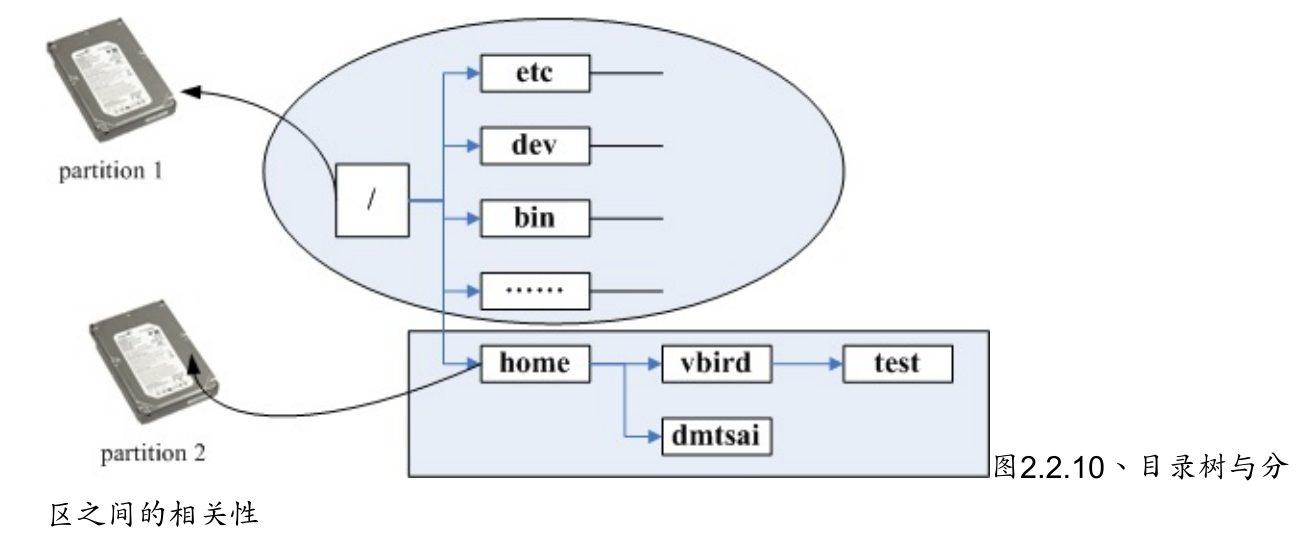
五、Linux文件权限与目录配置
5.1使用者与群组
5.2Linux文件权限概念
5.2.1 Linux文件属性

- 文件拥有者可具备的权限
- 加入此群组之帐号的权限
- 非本人且没有加入本群组之其他帐号的权限
5.2.2 改变文件属性和权限
-
chgrp: 改变文件所属群组
chgrp [group name] [file name] -
chown: 改变文件拥有者
chown [user name]:[group name] [file name] -
chmod: 改变文件权限
u,g,o三种身份权限- +(加入) -(除去) =(设置)
5.2.3 权限对目录的意义
| 内容 | r | w | x | |
|---|---|---|---|---|
| 文件 | 详细数据 | 读文件内容 | 写文件内容 | 执行文件内容 |
| 目录 | 文件名 | 读文件名 | 修改文件名 | 进入该目录的权限 |
5.3 目录配置
5.3.1 Filesystem Hierarchy Stantard
可分享的,不可分享的,不变的,可变的
根目录(/)所在分区越小越好,且应用程序安装的软件最好不要与根目录放在同一个分区内
/bin: 单人维护模式下还能执行的命令/boot:- Linux核心文件
- 开机菜单
- 开机所需配置文件
/dev: 外设/etc: 系统配置文件/etc/modprobe.d/模块装载时的配置文件/etc/passwd/etc/fstab系统挂载
/lib:- 开机使用的函数库
/bin和/sbin指令调用的函数库
/media: 媒体/mnt: 暂时挂载额外设备/opt: 第三方协力软件/run: 开机后所产生的各项信息/sbin: 开机过程需要的,包括了开机、修复和还原系统需要的指令/srv: service缩写,网络服务启动后的数据目录,比如WWW,FTP/usr: Unix操作系统软件资源,可分享的和不可变动的FHS建议 所有软件开发者,应该将他们的数据合理的分别放置到这个目录下的次目录,而不要自行创建该软件自己独立的目录。/usr/bin: 系统可执行命令的主要目录/usr/lib:/usr/local: 自行安装, 非distribution默认/usr/sbin: 非系统正常运行需要的指令/usr/share
/var: 主要针对常态性变动的文件,包括高速缓存(cache)、登录文件(log file)以及某些软件运行所产生的文件, 包括程序文件(lock file,run file),或者例如MySQL数据库的文件/var/cache: 程序本身运行过程中的暂存盘/var/lib: 程序执行过程中需要用到的数据文件放置目录/var/lock: 确保某些文件或者硬件只会给单一软件使用/var/log: 登陆文件目录/var/log/wtmp: last命令
/var/run: 程序和服务的PID
/home/liv64: 与/lib不同格式的二进制函数库/root: 系统管理员的主文件夹/lost+found/proc: 虚拟文件系统,放置的数据在内存中/proc/cpuinfo/proc/interrupts: 中断/proc/meminfo/proc/swaps/proc/version: 内核版本/proc/mounts
/sys
5.3.2 目录树
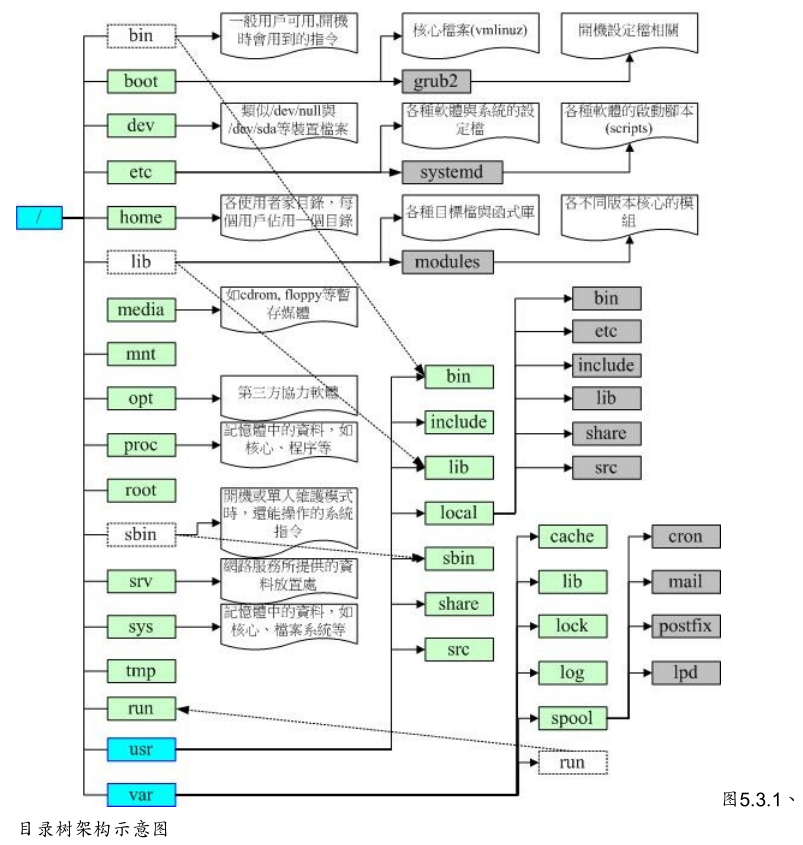
六、Linux文件与目录管理
pwd -P: 显示确实的路径,也就是link目录的原目录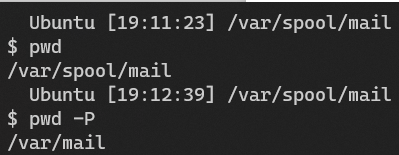
mkdir -m 711 test2: 设置文件权限